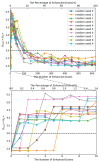Simulation of Abnormal Grain Growth Using the Cellular Automaton Method
- PMID: 38203990
- PMCID: PMC10779783
- DOI: 10.3390/ma17010138
Simulation of Abnormal Grain Growth Using the Cellular Automaton Method
Abstract
The abnormal grain growth of steel, which is occurs during carburization, adversely affects properties such as heat treatment deformation and fatigue strength. This study aimed to control abnormal grain growth by controlling the materials and processes. Thus, it was necessary to investigate the effects of microstructure, precipitation, and heat treatment conditions on abnormal grain growth. We simulated abnormal grain growth using the cellular automaton (CA) method. The simulations focused on the grain boundary anisotropy and dispersion of precipitates. We considered the effect of grain boundary misorientation on boundary energy and mobility. The dispersion state of the precipitates and its pinning effect were considered, and grain growth simulations were performed. The results showed that the CA simulation reproduced abnormal grain growth by emphasizing the grain boundary mobility and the influence of the dispersion state of the precipitate on the occurrence of abnormal grain growth. The study findings show that the CA method is a potential technique for the prediction of abnormal grain growth.
Keywords: carburizing; cellular automaton; grain growth.
Conflict of interest statement
Author Kenji Murata is employed by the company Daido Steel Co., Ltd. The remaining authors declare that the research was conducted in the absence of any commercial or financial relationships that could be construed as a potential conflict of interest.
Figures












References
-
- Ivasishin O.M., Shevchenko S.V., Vasiliev N.L., Semiatin S.L. 3D Monte-Carlo Simulation of Texture-Controlled Grain Growth. Acta Mater. 2003;51:1019–1034. doi: 10.1016/S1359-6454(02)00505-0. - DOI
-
- Saito Y., Enomoto M. Monte Carlo Simulation of Grain Growth. ISIJ Int. 1992;32:267–274. doi: 10.2355/isijinternational.32.267. - DOI
-
- Atkinson H.V. Overview No. 65. Acta Metall. 1988;36:469–491. doi: 10.1016/0001-6160(88)90079-X. - DOI
-
- Yu Q., Esche S.K. Three-Dimensional Grain Growth Modeling with a Monte Carlo Algorithm. Mater. Lett. 2003;57:4622–4626. doi: 10.1016/S0167-577X(03)00372-0. - DOI
-
- Lan Y.J., Li D.Z., Li Y.Y. A Mesoscale Cellular Automaton Model for Curvature-Driven Grain Growth. Metall. Mater. Trans. B. 2006;37:119–129. doi: 10.1007/s11663-006-0091-y. - DOI
LinkOut - more resources
Full Text Sources

